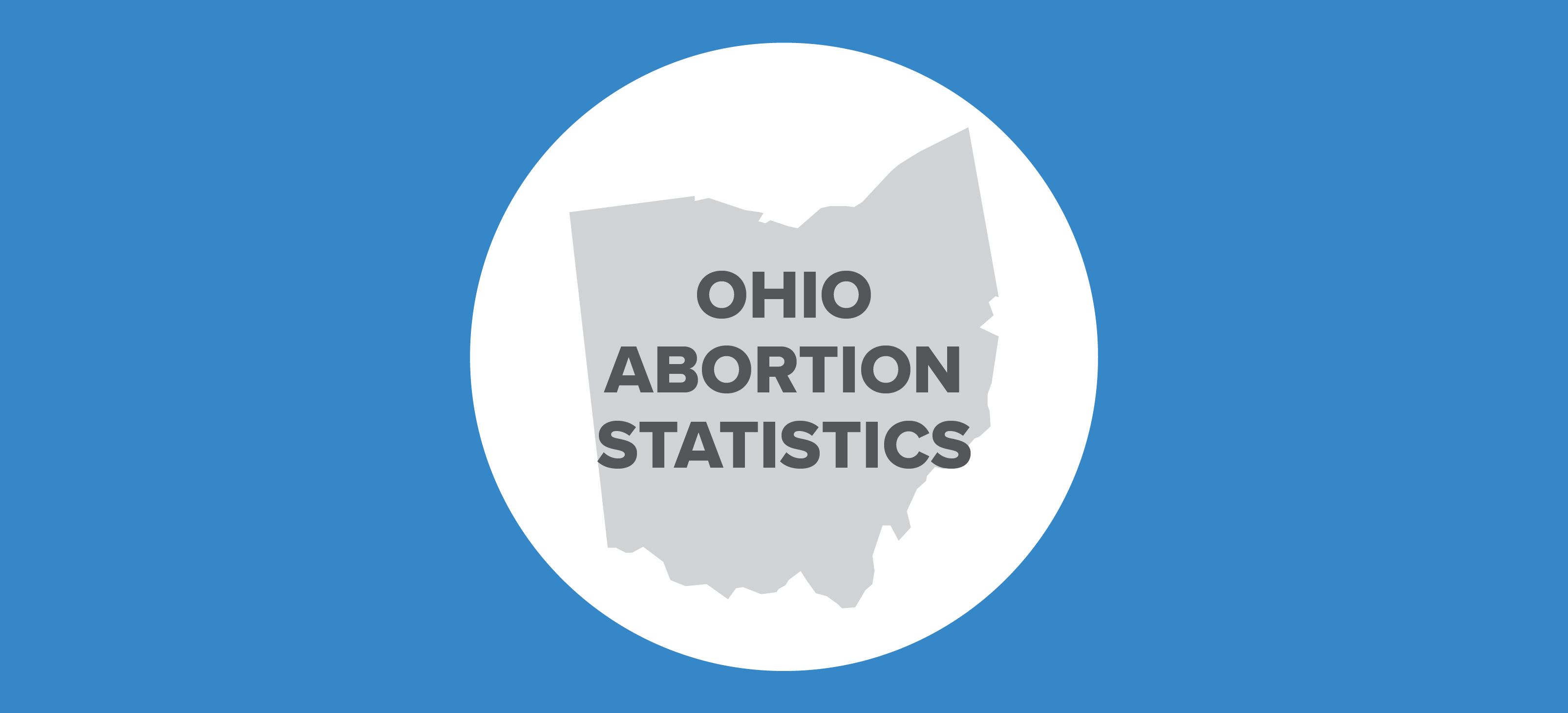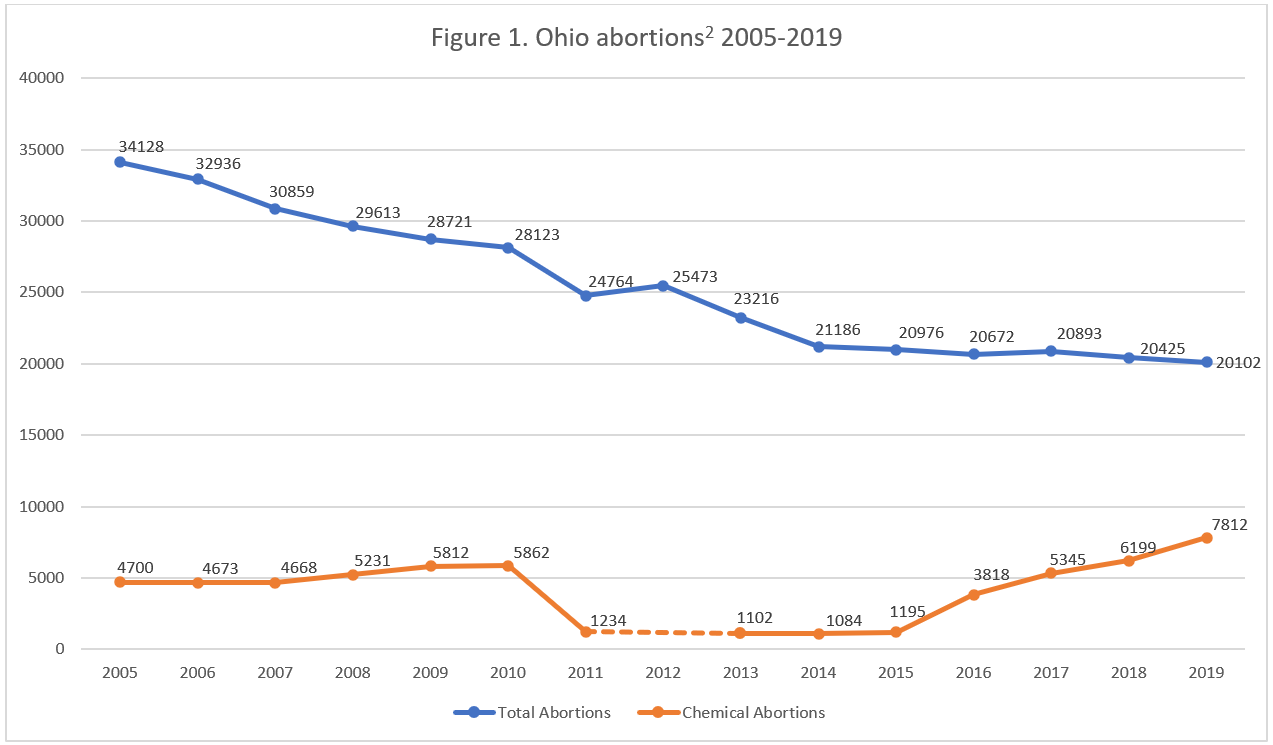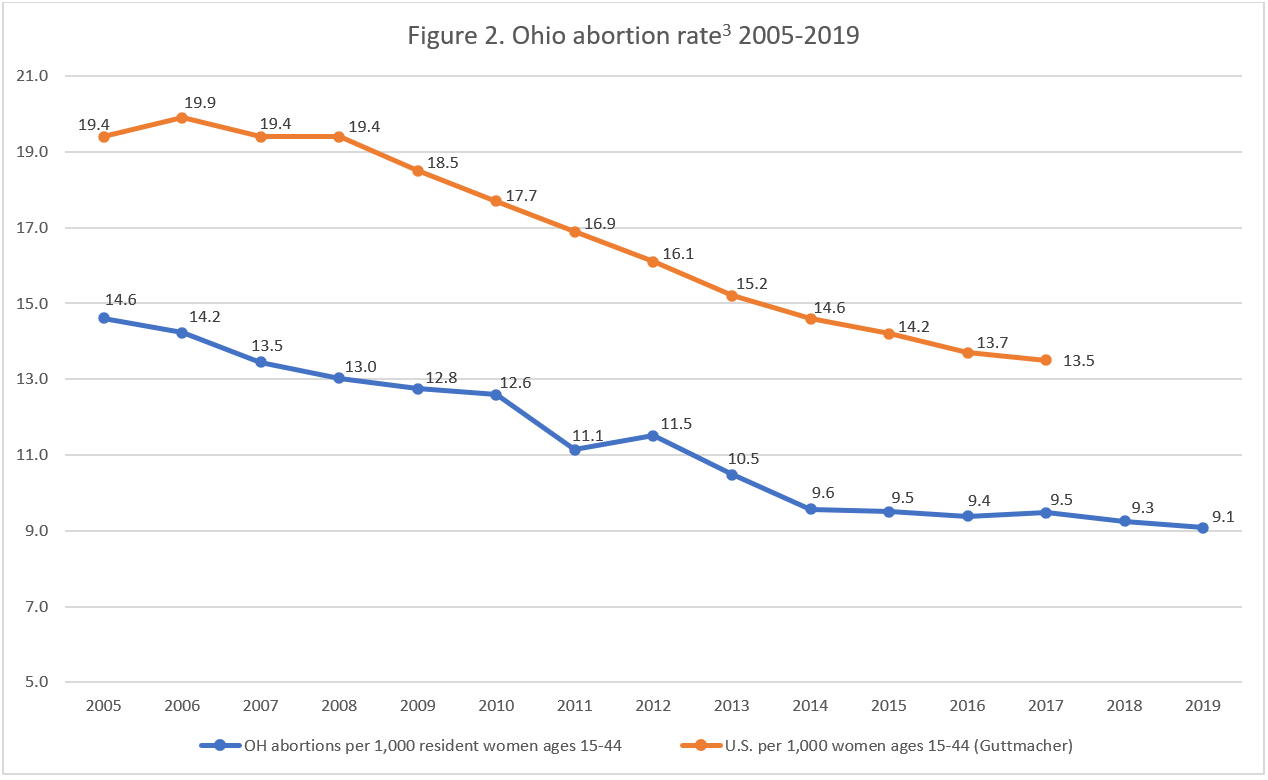Abortion Reporting: Ohio (2019)

Ohio’s 2019 abortion report was published by the Ohio Department of Health in October 2020. The report shows that chemical abortions in Ohio continue to increase.
Changes in Ohio Abortions, 2018-2019

The report does not include information on Planned Parenthood’s Ohio market share.
Abortion Totals and Trends
In 2019, there were 20,102 abortions reported in Ohio, down almost two percent from the year before (Fig. 1). However, over the same time period, chemical abortions increased by 26 percent, from 6,199 in 2018 to 7,812 in 2019. Chemical abortions composed 39 percent of the total in 2019. The Charlotte Lozier Institute (CLI) estimates that Ohio’s 2019 abortion rate was 9.1 abortions per 1,000 women ages 15 to 44, down two percent from 2018 and lower than the national rate (Fig. 2).
State Report Summary
The vast majority of the abortions reported in Ohio in 2019 (94 percent) were performed on state residents, and six percent were performed on women from other states, although Ohio does not identify the states from which women traveled. Nine percent of Ohio abortions were performed on girls under the age of 20, including three percent on girls under the age of 18. Fifty-nine percent of the abortions were on women in their twenties (29 percent on women ages 20 to 24 and 30 percent on women ages 25 to 29), while 28 percent were on women in their thirties. Three percent of the abortions were on women age 40 or older.
Forty-five percent of the women undergoing abortions in Ohio were white, and 42 percent were black. Four percent of the abortions were performed on women of multiple races, and three percent were on Asian or Pacific Islander women. A small number (0.3 percent) were on American Indian women. Race was unknown or not reported for six percent of the abortions. CLI estimates that white women experienced the lowest abortion rate of all racial groups (5.2 abortions per 1,000 women ages 15 to 44) while black women experienced the highest (25.6), five times the abortion rate for white women. Eighty percent of the abortions were performed on non-Hispanic women, five percent were on Hispanic women, and over 14 percent were on women of unknown ethnicity.
Most of the abortions reported in Ohio were on women who had finished high school. Thirty-seven percent were on women who reported a high school diploma or equivalent as their highest level of education, 23 percent were on women who had attended college but had no degree, and 21 percent were on women with an associate’s degree or higher. In contrast, 12 percent of the abortions were on women who had not finished high school. Education was not reported for seven percent of the women undergoing abortions in Ohio. Similarly, marital status was not reported for seven percent of the women getting abortions, while 80 percent of the abortions were on unmarried women and 13 percent on married women.
Nearly three-quarters of the abortions reported in Ohio were on women who had had at least one previous pregnancy. A quarter were performed on women who had one living child, and 38 percent on women with two or more living children. Thirty-nine percent of the abortions occurred to women who previously had an abortion (24 percent on women with one prior abortion and 16 percent on women with more than one). Nineteen percent were obtained by women who had had a miscarriage. In contrast, 35 percent of the abortions were on women with no living children, 58 percent on women with no previous abortions, and 79 percent on women who had never had a miscarriage. Less than a fifth of the women undergoing abortions in 2019 reported using contraception at the time they became pregnant. Sixty-three percent were not using contraception, and 18 percent did not report their contraceptive use. This pattern was similar to the previous year, when 62 percent were not using contraception and 17 percent did not indicate whether they were using contraception.
A majority of Ohio abortions occurred early in pregnancy, with 61 percent reported at eight completed weeks of gestation or earlier. Twenty-six percent were performed between nine and 12 weeks, and 11 percent were between 13 and 18 weeks of gestation. Just over one percent occurred between 19 and 20 weeks, while less than half a percent (95 abortions) were reported between 21 and 24 weeks of gestation. No abortions were reported to occur after 24 weeks. Ultrasound was used to determine gestational age in advance of the vast majority of abortions (93 percent). The last menstrual period was used to calculate gestational age ahead of seven percent of the abortions, and clinical exams and other methods were used to estimate gestational age for a few abortions.
Ohio prohibits abortions on viable unborn babies unless the mother’s life or a major bodily function is at risk. After 19 completed weeks of gestation (the beginning of the 20th week of gestation), a doctor must test to see if the unborn baby is viable before beginning the abortion, unless there is a medical emergency. In 2019, there were 356 abortions performed after 19 completed weeks of gestation. Of these, one was judged to be viable, and 355 were not viable. The report does not indicate whether the viable baby was aborted due to a medical emergency, but 14 women were reported to have medical conditions other than “good” at the time of their abortions. Ohio limits abortion at 20 weeks post-fertilization (approximately 22 weeks of gestation). Of the 356 abortions reported after 19 completed weeks of gestation, seven were performed at or after 20 weeks post-fertilization, or around 22 weeks of gestation; the report does not indicate the grounds for these abortions.
Ohio allows multiple abortion methods to be reported for each abortion. In 2019, 20,116 individual procedures were reported to have been used, just over the 20,102 abortions that occurred in the state. Half of these (50 percent) were suction curettage procedures. Eleven percent were dilation and evacuation abortions, and 39 percent were chemical or nonsurgical abortions. Dilation and extraction was used for three abortions and hysterectomy for three abortions. There were two abortions performed using other surgical methods, and five abortions for which the methods were not reported. In 2019, 93 percent of Ohio abortions were performed in ambulatory surgical facilities. Seven percent occurred at non-surgical abortion facilities, and 0.2 percent were performed in hospitals.
A majority of the women undergoing abortions in Ohio received some type of counseling; each woman could receive more than one type. More than two-thirds of the women who got abortions received medical counseling (67 percent), and 14 percent received social services counseling. Fourteen women received psychological counseling, and another 14 received pastoral counseling, while two were given some other type of counseling. A third of the women did not receive counseling. Ohio has a separate informed consent process to ensure that all women seeking abortion are provided with medical information and made aware of available resources. However, Ohio’s abortion report does not include information on the informed consent process.
Abortion Complications
Ohio collects information on abortion complications from three sources.1 Complications occurring at the time of the abortion are reported using the abortion reporting form, while complications identified later are reported by the treating physician using a post-abortion care report form. Additionally, complications caused by chemical abortions are reported to both the state health department and the state medical board, but the medical board statistics are not included in the annual abortion report. The annual report does not attempt to merge data from the two complication reporting forms.
In 2019, 25 abortions resulted in 31 immediate complications that were reported using the abortion reporting form. The most commonly reported complication was failed abortion, occurring in eight cases. There were five cases of hemorrhaging and five incomplete abortions, while uterine perforation, hematometra, and complications related to the anesthetic each occurred once. Additionally, there were 10 other, unspecified complications that occurred during abortion procedures.
There were 111 abortions that resulted in 123 complications that were reported subsequent to the abortion procedure using the post-abortion care report form. Of these, the most frequent were failed abortion, occurring in 48 cases, and incomplete abortion, reported in 40 cases. There were 11 instances of hematometra and 10 hemorrhages. Uterine perforation, infection, and Rh incompatibility all occurred one time, and there were 11 unspecified complications. Abortions performed between nine and 12 weeks of gestation were the most likely to result in complications, causing reported complications 0.8 percent of the time, largely due to a high number of failed abortions.
State Ranking
In 2016, CLI evaluated abortion reporting across the country, and Ohio’s reporting tied for third best. To further improve its reporting, Ohio could identify the number of complications resulting from each type of abortion procedure, including chemical abortions, which would allow for comparison with the Ohio medical board’s RU-486 (mifepristone) adverse event data. Ohio could also differentiate between primary and secondary procedures used to perform abortions. Additionally, Ohio could list the states from which women travel for abortions.


- Statistics on abortion complications reported here represent a minimal number of deaths and complications, as this data is collected in a non-systematic and non-verifiable way. As such, this data cannot be used to calculate either an accurate abortion mortality rate or an accurate abortion complication rate for the state.
- This chart does not contain the number of chemical abortions reported in 2012. Ohio changed its abortion report formatting between 2011 and 2012, and the Ohio Department of Health was not able to confirm the number of chemical abortions reported in 2012.
- Rates were calculated by CLI using population estimates from the United States Census Bureau. The rates were calculated using the following formula: (total number of abortions performed in Ohio ÷ number of resident women ages 15-44) x 1,000. Rates may differ slightly from previous CLI articles due to revised population estimates.























